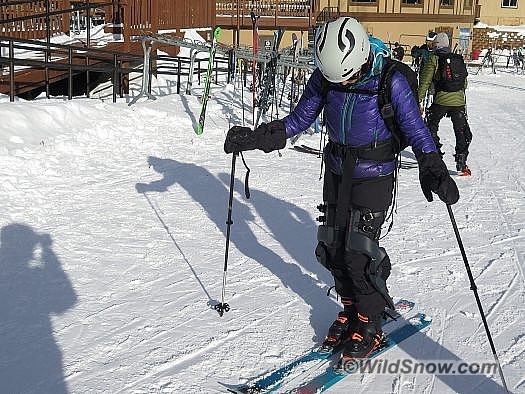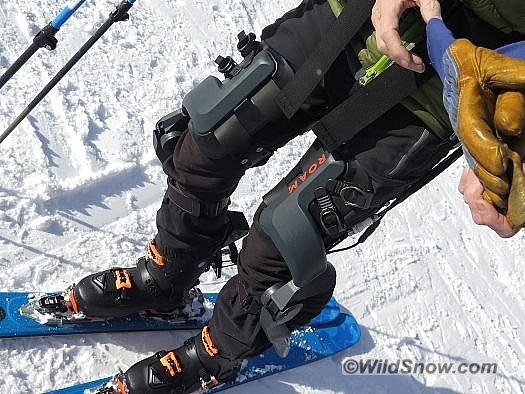Lisa and I have been at a press even the last few days. The usual stuff. Ski the latest DPS and Dynafit skis (and yes Virginia, Hoji Free beef boot launched), check out Sweet Protection’s helmets, ski at the sweet little Eldora ski resort out of Boulder, Colorado. And watch people strap into the Roam exoskeleton to become Iron Men, and Women, of the slopes.
Roam was founded by its CEO Tim Swift. As a veteran of the robotics and exoskeleton arena, he saw the limits of the heavy, incredibly expensive metallic exoskeletons most developers were experimenting with. So he founded Roam to develop a “lightweight, low cost machine, made from fabric and plastics.” Result, a variety of commercialized exoskeleton products. Focus for us, a Roam machine specific for skiing, the Elevate, that’s now launched and ready for rental.
The Elevate device “offloads up to 30% of the user’s body weight.” In other words, effort from your leg muscles and pressure on your knees is transferred to the device’s hinge and motors (and subsequently to your skeletal structure and boot soles).
In appearance, Elevate is what you’d expect: a somewhat bulky contraption that resembles a high-end knee brace. The secret sauce is in the actuators that apply power to the skeleton. Instead of gears and pistons (fictional or real), Roam uses elegantly designed compressed air motors made from textiles and plastic. This rig is no toy, but in the words of Swift, “We use manufacturing processes common to the toy industry, so we can keep costs down.”
Power comes from a battery powered portable compressor you carry on your back. Everything is remarkably compact and lightweight, designed for the least “Avengers” look possible. Nonetheless, the twelve pound compressor backpack is perhaps too heavy for less robust or elderly skiers (especially those with back problems) — and those are clearly the demographics for the Elevate market. Swift says the entire system is in a constant state of revision, with goals being “less weight and sleeker appearance.”
Speaking of markets, we were told that while the Elevate device is strictly for downhill skiing, Roam’s products for hiking and running could likely lead to something for uphill skiing, though nobody denied the weight of the system would need to be greatly reduced for actual backcountry use.
Our take? We see a robust rental market for the Elevate we tested, though we feel it needs a few more design iterations before you’ll want to buy one. As for philosophy, look at it like a pedallic E-bike. Elevate does not ski for you, but instead it skis with you, to keep you on the slopes as life progresses.
Below, Lisa’s testing experience:
After decades of backcountry skiing and trail running, my knees have deteriorated to squeaky, bone-on-bone hinges. The orthopod encourages me to get a double knee replacement. Fearful of the knife, I’m putting it off as long as possible. I gulp Advil to mask the pain, or sometimes I’ll stay home instead of wincing down the slopes. I fantasize about strapping on an exoskeleton and gliding down a peak as nimble as a chamois.
Roam Robotics brought my dream closer to reality. During a press event at Eldora Ski area here in Colorado, I had an opportunity to try Roam’s robotic ski leg support, the Elevate. The plan was to strap the robotic frame to each of my legs and go skiing.
My appointment for the test run was late afternoon. As preparation, I did not take any pain relievers for 48 hours prior. My morning was free so I skinned up the ski area. On the first turns down the slope, pain shot thru my legs like a dentist hitting a nerve. I gingerly made wide zorro turns and slowly got down to the lodge where I hung out until my meeting with Roam.
At 3:00, Roam techs fitted the contraptions to my legs. We rode the chairlift up the slope and got ready to launch down. I slowly made a turn, then another and another, each faster and more fluid. I kid you not: no pain at all. By the end of the run, I was making the carefree turns of my youth.
Skiing with the Elevate exosketelon was curiously subtle. Other than eliminating my knee pain, it didn’t seem like the robotic supports were doing anything drastic. I heard the air compressor powering up and releasing the brace as I went in and out of turns but it didn’t feel like I was getting thrown around by it. There was merely a lightened load on my knees and legs, like the gravitational pull wasn’t so strong.
Halfway down the run, I turned off the device and skied a few turns. My knees screamed with pain. I turned the device back on and my knees stopped crying. I wasn’t dreaming, the exoskeleton was indeed helping me.
As with any new invention, there’s room for improvement and the engineers at Roam Robotics are continually perfecting the apparatus. Roam Robotics will have a limited amount of rentals available at a few locations in the US. Check out their website for details.
I’m excited to see Elevate evolve and hope Roam Robotics is successful with bringing it to market. The ability to ski with an exoskeleton like the Elevate would allow me to postpone my knee replacements, maybe forever. And when they perfect the cliff jumping code in the algo, who knows, Lou might have to buy a different camera.
WildSnow.com publisher emeritus and founder Lou (Louis Dawson) has a 50+ years career in climbing, backcountry skiing and ski mountaineering. He was the first person in history to ski down all 54 Colorado 14,000-foot peaks, has authored numerous books about about backcountry skiing, and has skied from the summit of Denali in Alaska, North America’s highest mountain.


